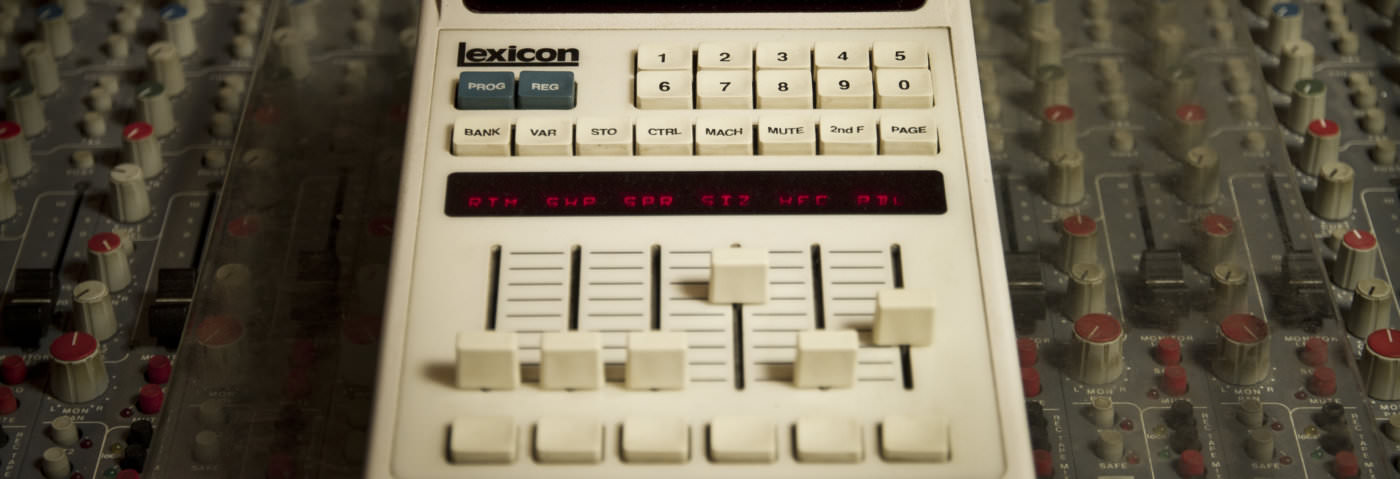Lexicon 224
Like so many other studio mainstays, artificial reverb effects were first developed in the analogue era and later updated and developed further as digital technology began to take over. German audio equipment manufacturers EMT, not content with just about perfecting the plate reverb with the EMT 140, pioneered digital reverb with the 250, released way back in 1976.
The 250 was a revolutionary unit, but it was superseded a couple of years later by a company whose name went on to be synonymous with top-quality digital reverb. Lexicon’s 224, released in 1978, was the first true industry standard digital reverb, capable of some of the smoothest, most useable reverb algorithms ever produced. The functional black rack unit itself might be nondescript, but the iconic LARC (Lexicon Alphanumeric Remote Control) unit can still be found resting conveniently on the mixing consoles of countless studios to this day.
some of the smoothest, most useable reverb algorithms ever produced
The 224 in particular marks an early high point for algorithmic reverb. Before the advent of convolution reverbs and more advanced forms of algorithmic modelling, the standard was for all digital reverb units to be based on relatively simplistic delay-based algorithms (albeit running on what was at the time cutting-edge digital signal processing hardware). That’s not to say that they didn’t sound good; indeed, with its 12-bit AD and DA conversion (again, the highest quality available at the time), the 224 offered exceptionally long, clear reverb tails.
The iconic status of the 224 means that a good working unit still commands a relatively high price, typically in the region of £1,500. More affordable Lexicon units such as the later PCM range offer a similar sound at a lower price point. However, it’s impossible to ignore the fact that software emulations of digital reverb units are all but indistinguishable from the real thing. Universal Audio’s Lexicon 224 Reverb plugin
uses exactly the same algorithms and control processor code found in the final iteration of the 224. For most users it’s a cheaper, more flexible and more convenient alternative to the original hardware.

03.00 PM
Excuse me but where is the Midiverb II at? What kind of dance music producer has a room for a plate reverb.
08.34 PM
Lumping the Space Echo in with reverbs seems to be pushing it a bit. It’s a great unit, but…
Also worth mentioning are the dirt-cheap plugins from ValhallaDSP (which borrow a lot of techniques from both Lexicon and Eventide), and the more expensive ones from 2CAudio.
02.34 PM
makes me laugh how people always get so mad at these features. guys, they’re just attack’s choices. if you don’t agree, write down your own list on a piece of paper and look at that instead. it’s hardly as if it’s some kind of official ranking, plus there’s a lot more to read here than just the names of 10 reverbs. maybe if you read it you’d realise they actually mentioned the midiverb AND the fact that most people don’t have room for a plate so should buy the plugin instead.
eric, i kind of agree with your point on the space echo but they are absolutely awesome for reverb as well as delay effects. even the delays are so messy and organic that it isn’t really delay as most people think of it these days. i got to borrow one off a friend for a while and what i actually liked it most for was a short reverb-style effect on vocal samples.
i also agree that the valhalla reverbs are excellent
10.16 PM
This is an unusually random feature from Attack…so few of these devices are really relevant to dance music eg the Lexicon 224…or EMT 140 (a vintage plate!)…’Acoustic space’ followed by a Bricasti! Its just all over the place…and honestly is that really relevant for dance music producers?
Here is my list:
2cAudio Aether
Valhalla Vintage Verb
Valhalla Shimmer
Relab 480
Eventide Black Hole pedal
Strymon Big Sky pedal
Eventide H3000 Rack unit
Roland Space Echo vintage delay
11.44 PM
Strymon Bluesky should’ve been in there